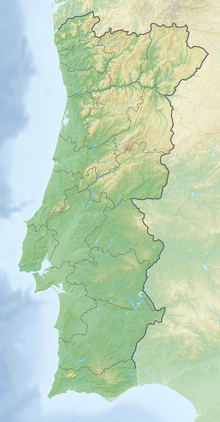Anta de Paredes
Location of the Anta de Paredes in Portugal. |
The Anta de Paredes , also called Anta da Herdade das Paredes , is a megalithic complex about 1.5 km north of Monte da Herdade de Paredes , in the municipality ( Portuguese Freguesia ) Nossa Senhora da Graça do Divor in the district ( Portuguese Concelho ) Évora , Évora district in the central Alentejo .
Anta , Mámoa , Dolmen , Orca and Lapa are the common names in Portugal for the approximately 5000 megalithic structures that were built during the Neolithic in the west of the Iberian Peninsula by the successors of the Cardial or Imprint culture .
Monument preservation
The system was described in 1878 by the Marquis de Nadaillac in the magazine La Nature and documented in drawings. Further descriptions followed in 1898 by José de Leite de Vasconcellos and in 1949 by Georg Leisner . An archaeological investigation of the site is still pending.
The megalithic tomb was registered and protected as a Monumento Nacional in 1910 and is located in an area that is now used for agriculture.
Finding
The site is located on a plateau on a hillside at the maturity of the Ribeira de Paredes , about 340 m northeast of also as Monumento Nacional registered Anta de Silvadas . Both Anten together with three other Anten in the immediate vicinity - Anta da Herdade do Silval 2–4 - form a small group of graves .
The polygonal burial chamber with a diameter of about 3 m and a height of about 2 m is formed by seven bearing stones ( orthostats ) made of granite and is closed with a capstone. The corridor leading to the burial chamber is 3.5 m long and approx. 1.5 m wide and high. Two heavily fragmented bearing stones and two cover plates of the corridor are still preserved. The cover plate closest to the burial chamber is decorated with 31 dimples.
The former hilltop ( Mámoa ) of the grave is still partially recognizable; its diameter is around 9 m and is still around 0.5 m high.
The Anta belongs to the group of megaliths of the Eborense type ( Portuguese “típico do megalitismo do aro eborense” or “universo megalítico eborense” ), the prototype of which is the Anta Grande da Comenda da Igreja in Montemor-o-Novo . Due to typological parallels, the complex dates from the end of the 4th millennium to the middle of the 3rd millennium BC. Dated.
Finds
Due to the pending archaeological investigation of the monument, no finds are known to date.
Individual evidence
- ↑ a b c Manuel Branco: Anta de Paredes . Direção-Geral do Património Cultural - Sistema de Informação para o Património Arquitectónico, 1993, accessed on June 13, 2018 (Portuguese).
- ↑ Decreto de 16-06-1910. (pdf) In: DG, n.º 136, de 23-06-1910. June 23, 1910, p. 2163 , accessed June 16, 2018 (Portuguese).
-
↑ Anta da Herdade do Silval 2 . Direção-Geral do Património Cultural - Portal do Arqueólogo, accessed June 17, 2018 (Portuguese). Anta da Herdade do Silval 3 . Direção-Geral do Património Cultural - Portal do Arqueólogo, accessed June 17, 2018 (Portuguese). Anta da Herdade do Silval 4 . Direção-Geral do Património Cultural - Portal do Arqueólogo, accessed June 17, 2018 (Portuguese).
- ^ A. Martins: Anta de Paredes . Direção-Geral do Património Cultural, accessed June 13, 2018 (Portuguese).
- ↑ a b Anta de Paredes / Anta da Herdade das Paredes . Direção-Geral do Património Cultural - Portal do Arqueólogo, accessed May 17, 2018 (Portuguese).
literature
- A. Martins: Anta de Arca . Direção-Geral do Património Cultural, accessed on January 20, 2018 (Portuguese, with extensive literature sv Bibliografia).
Web links
Coordinates: 38 ° 39 ′ 45.7 ″ N , 8 ° 2 ′ 20.1 ″ W.

